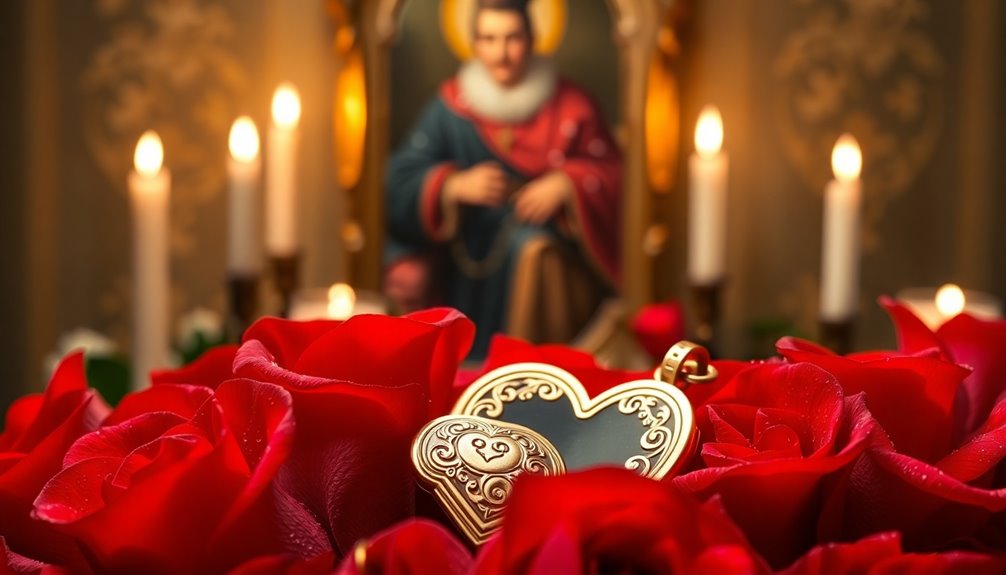Valentine's Day, celebrated on February 14, has its origins in the ancient Roman festival of Lupercalia, which honored love and fertility. The holiday honors Saint Valentine, a priest who defied Emperor Claudius II by marrying couples in secret, ultimately leading to his martyrdom. Over time, it evolved into a celebration of romantic love, featuring gifts like roses and chocolates. If you explore further, you'll uncover fascinating details about its rich history and traditions.
Key Takeaways
- Valentine's Day is celebrated on February 14, originating from the ancient Roman festival of Lupercalia, which included fertility rites and pairings.
- The holiday honors Saint Valentine, a priest who defied Emperor Claudius II by marrying couples, leading to his martyrdom.
- By the 14th century, Valentine's Day evolved into a celebration of romantic love, incorporating symbols like roses, Cupid, and hearts.
- The day has been adapted globally, with various cultures incorporating local traditions to express love and affection.
- Commercialization has transformed Valentine's Day into a significant retail event, with increased sales of cards and gifts reflecting societal values of love.

Valentine's Day, celebrated on February 14, has a rich history that intertwines ancient traditions, Christian influences, and evolving cultural practices. You might be surprised to learn that its origins trace back to the ancient Roman festival of Lupercalia, held on February 15. This event included fertility rites and even paired women with men through a lottery system.
Over time, as the Catholic Church sought to replace these pagan rituals, it established St. Valentine's Day in the 5th century, likely honoring a Christian martyr named Valentine.
The life of Saint Valentine adds layers to the holiday's meaning. Multiple legends surround him, including the tale of a priest who secretly married couples against Emperor Claudius II's orders. His actions led to his martyrdom on February 14, a day that would become synonymous with love. Because of his association with marriage, he's often regarded as the patron saint of lovers, symbolizing devotion and sacrifice. Several Christian martyrs named Valentine contributed to the holiday's rich lore and significance.
As the centuries rolled on, Valentine's Day transformed into a celebration of love and romance, especially during the 14th century. You'll notice this evolution in the customs we practice today, which include exchanging gifts like red roses and chocolates—symbols of beauty and affection.
Cupid, the Roman god of love, along with hearts and birds, became ubiquitous symbols, representing the season of mating that aligns with mid-February.
The holiday has also become more secular over time, focusing on romantic love and friendship. Different cultures have adapted Valentine's Day to fit their traditions, leading to global celebrations filled with various customs.
As commercialization took hold, the sale of cards and gifts skyrocketed, turning it into a major retail event. Influenced by literary works, particularly those of Geoffrey Chaucer, Valentine's Day now reflects societal values about love and relationships, allowing you to celebrate affection in your own unique way.
Frequently Asked Questions
How Do Different Cultures Celebrate Valentine's Day?
Different cultures celebrate Valentine's Day in unique ways.
In France, you might exchange heartfelt letters, while in Japan, you'll give chocolates to men and expect a return gift on White Day.
South Korea blends Western traditions with local customs, and in Colombia, you'll focus on friendship.
If you're in Italy, expect gifts like hazelnut chocolates.
Each celebration reflects the culture's values, making Valentine's Day a vibrant global event for love and connection.
What Are Some Popular Valentine's Day Gifts?
When you think of Valentine's Day, you might picture a romantic dinner or a cozy night in, yet gifts play a crucial role, too.
Chocolates and roses are classic choices that never go out of style. For something unique, consider personalized items or luxury spa baskets.
If you want to get creative, think about experiences like cooking classes or subscription services.
Whatever you choose, it's the thought that truly counts!
Are There Any Valentine's Day Traditions Around the World?
Absolutely! Valentine's Day traditions vary worldwide.
In the U.S., you exchange cards and gifts, while in Japan, women give chocolates to men, who reciprocate on White Day.
In Mexico, you celebrate both romantic and platonic love.
Meanwhile, the Philippines hosts mass weddings, and in Italy, couples share *baci perugina* chocolates with love notes.
Each culture adds its unique twist to expressing love, making the day special in many different ways.
How Has Valentine's Day Evolved Over the Years?
Valentine's Day has transformed remarkably over the years, shifting from a religious feast day to a commercial celebration of love.
Picture secret marriages in ancient Rome, then leap to the Victorian era's mass-produced cards.
Today, you exchange gifts and enjoy romantic dinners, while Galentine's Day celebrates friendships.
This evolution highlights how the holiday adapts, blending traditions and modern expressions of love, making it a vibrant cultural event that resonates with many.
What Is the Economic Impact of Valentine's Day?
Valentine's Day has a significant economic impact, with spending projected to hit $27.5 billion by 2025.
You'll likely spend about $188.81 on gifts like candy, flowers, and jewelry.
With over half of consumers planning to celebrate, this holiday boosts retail sectors, creating jobs and driving sales, especially in dining and confectionery.
The holiday not only affects individual budgets but also influences broader economic trends and consumer behavior.
Conclusion
As you celebrate Valentine's Day, think of Saint Valentine as a symbol of love's enduring power. Just like the heart-shaped chocolates and roses exchanged, his legacy reminds us that love can conquer all obstacles. Whether you're sharing a romantic dinner or a heartfelt note with a friend, let the spirit of Valentine inspire you to cherish the connections in your life. After all, love, in its many forms, is the brightest flame that lights our paths.










